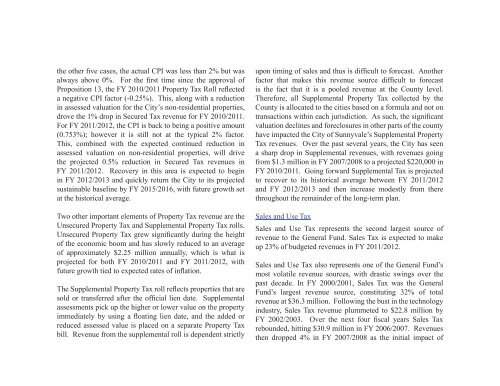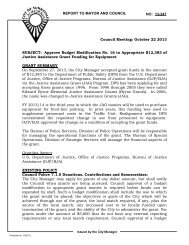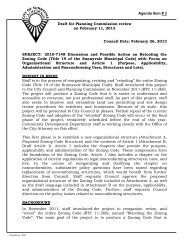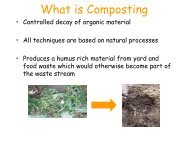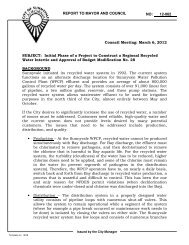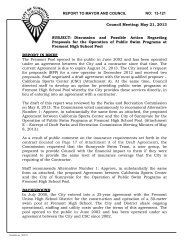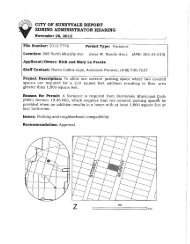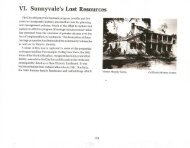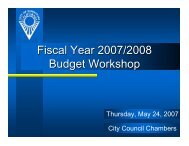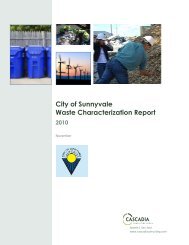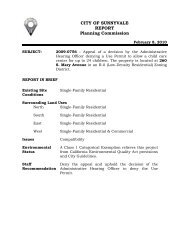20-Year Resource Allocation Plan - City of Sunnyvale
20-Year Resource Allocation Plan - City of Sunnyvale
20-Year Resource Allocation Plan - City of Sunnyvale
You also want an ePaper? Increase the reach of your titles
YUMPU automatically turns print PDFs into web optimized ePapers that Google loves.
the other fi ve cases, the actual CPI was less than 2% but was<br />
always above 0%. For the fi rst time since the approval <strong>of</strong><br />
Proposition 13, the FY <strong>20</strong>10/<strong>20</strong>11 Property Tax Roll refl ected<br />
a negative CPI factor (-0.25%). This, along with a reduction<br />
in assessed valuation for the <strong>City</strong>’s non-residential properties,<br />
drove the 1% drop in Secured Tax revenue for FY <strong>20</strong>10/<strong>20</strong>11.<br />
For FY <strong>20</strong>11/<strong>20</strong>12, the CPI is back to being a positive amount<br />
(0.753%); however it is still not at the typical 2% factor.<br />
This, combined with the expected continued reduction in<br />
assessed valuation on non-residential properties, will drive<br />
the projected 0.5% reduction in Secured Tax revenues in<br />
FY <strong>20</strong>11/<strong>20</strong>12. Recovery in this area is expected to begin<br />
in FY <strong>20</strong>12/<strong>20</strong>13 and quickly return the <strong>City</strong> to its projected<br />
sustainable baseline by FY <strong>20</strong>15/<strong>20</strong>16, with future growth set<br />
at the historical average.<br />
Two other important elements <strong>of</strong> Property Tax revenue are the<br />
Unsecured Property Tax and Supplemental Property Tax rolls.<br />
Unsecured Property Tax grew signifi cantly during the height<br />
<strong>of</strong> the economic boom and has slowly reduced to an average<br />
<strong>of</strong> approximately $2.25 million annually, which is what is<br />
projected for both FY <strong>20</strong>10/<strong>20</strong>11 and FY <strong>20</strong>11/<strong>20</strong>12, with<br />
future growth tied to expected rates <strong>of</strong> infl ation.<br />
The Supplemental Property Tax roll refl ects properties that are<br />
sold or transferred after the <strong>of</strong>fi cial lien date. Supplemental<br />
assessments pick up the higher or lower value on the property<br />
immediately by using a fl oating lien date, and the added or<br />
reduced assessed value is placed on a separate Property Tax<br />
bill. Revenue from the supplemental roll is dependent strictly<br />
upon timing <strong>of</strong> sales and thus is diffi cult to forecast. Another<br />
factor that makes this revenue source diffi cult to forecast<br />
is the fact that it is a pooled revenue at the County level.<br />
Therefore, all Supplemental Property Tax collected by the<br />
County is allocated to the cities based on a formula and not on<br />
transactions within each jurisdiction. As such, the signifi cant<br />
valuation declines and foreclosures in other parts <strong>of</strong> the county<br />
have impacted the <strong>City</strong> <strong>of</strong> <strong>Sunnyvale</strong>’s Supplemental Property<br />
Tax revenues. Over the past several years, the <strong>City</strong> has seen<br />
a sharp drop in Supplemental revenues, with revenues going<br />
from $1.3 million in FY <strong>20</strong>07/<strong>20</strong>08 to a projected $2<strong>20</strong>,000 in<br />
FY <strong>20</strong>10/<strong>20</strong>11. Going forward Supplemental Tax is projected<br />
to recover to its historical average between FY <strong>20</strong>11/<strong>20</strong>12<br />
and FY <strong>20</strong>12/<strong>20</strong>13 and then increase modestly from there<br />
throughout the remainder <strong>of</strong> the long-term plan.<br />
Sales and Use Tax<br />
Sales and Use Tax represents the second largest source <strong>of</strong><br />
revenue to the General Fund. Sales Tax is expected to make<br />
up 23% <strong>of</strong> budgeted revenues in FY <strong>20</strong>11/<strong>20</strong>12.<br />
Sales and Use Tax also represents one <strong>of</strong> the General Fund’s<br />
most volatile revenue sources, with drastic swings over the<br />
past decade. In FY <strong>20</strong>00/<strong>20</strong>01, Sales Tax was the General<br />
Fund’s largest revenue source, constituting 32% <strong>of</strong> total<br />
revenue at $36.3 million. Following the bust in the technology<br />
industry, Sales Tax revenue plummeted to $22.8 million by<br />
FY <strong>20</strong>02/<strong>20</strong>03. Over the next four fi scal years Sales Tax<br />
rebounded, hitting $30.9 million in FY <strong>20</strong>06/<strong>20</strong>07. Revenues<br />
then dropped 4% in FY <strong>20</strong>07/<strong>20</strong>08 as the initial impact <strong>of</strong>


